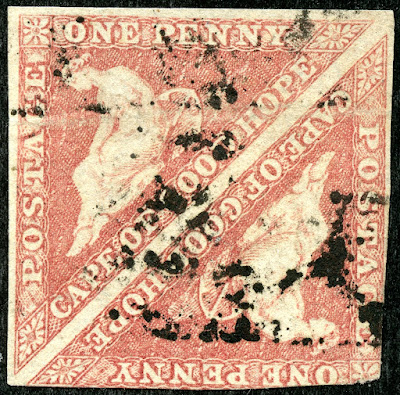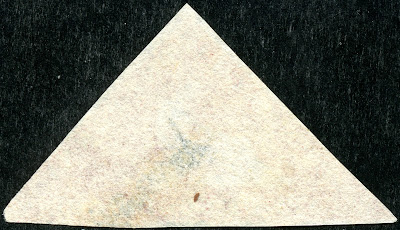COGH 1853 SG 3 1p brick red/ slightly blued paper
Scott 1 brick red/ bluish paper
Into the Deep Blue
The One Penny Reds, intended initially for newspapers, offers a nice challenge for collectors, not the least that the CV runs in the $300-$400 range, about 2-3X as much as the Four Pence Blues.
It follows much like the history of Great Britain 1841-1869 One Penny Reds/ Two Penny Blues, also manufactured by Perkins, Bacon, in the complexity of the issues.
This One Penny Part A post is the third in the COGH series. It will cover the Perkins, Bacon One Pence issued stamps of 1853 (blued paper) and 1855-58 (white paper). The Part B post, the next one, will review the 1863-64 De La Rue One Penny issues.
1858 Stanley Gibbons (SG) 5a rose/ white paper (Block)
The Perkins Bacon printed issues of 1853 and 1855-58 for the One Penny denomination come in three basic colors, according to SG: Namely "brick-red", "rose" and "deep rose-red".
The "rose" color is the most common (CV $325), and so we will begin there.
The One Penny block (above) is in the "rose" color range. If the block didn't have a crease running through it, the CV would be $750. But, let's look at the watermark placement....
1858 Stanley Gibbons (SG) 5a rose/ white paper (Block)
Note the two "Anchor" watermarks placed sideways between the two stamps
(9 o'clock & 3 o'clock position)
Normally, the "anchor" watermark hangs down vertically from the pyramid tip towards the pyramid base. But if the paper is fed for printing "upside-down", one ends up with so called "sideways" watermarks. They are not that common and command a premium (CV $700 for one stamp).
1858 Stanley Gibbons (SG) 5a rose/ white paper
(Scott 3 "rose")
Let's look at a couple more examples of the "rose" color. They were issued beginning in 1858, according to SG ( Scott says 1857). SG has "5a" for the catalog number. Although most of us in the USA generally follow Scott numbers, for the COGH triangles, SG numbers are more popular for serious COGH triangle collectors.
1858 Stanley Gibbons (SG) 5a rose/ white paper
(Scott 3 "rose")
Note that I always show the back of the stamp? That is because the 1858 PB "rose" stamps are on white or cream colored paper (a distinguishing characteristic). In contrast, the 1853 PB issue was on "blued" paper, as we will see later.
1858 Stanley Gibbons (SG) 5a rose/ white paper (Block)
(This might be an example of Scott 3a "dull red")
One problem with using two catalogs (SG, Scott) is trying to reconcile the different colors/numbers.
For SG, they divide the "rose" category stamps into "rose" (SG5a) and "deep red rose" (SG5b). This stamp block has a different "rose" hue than the other "rose" stamps shown, but probably not enough to call this block "deep red rose".
Now Scott divides the catalog into "rose" (Sc3) and "dull red" (Sc 3a). To me, this color hue shown above might be what Scott had in mind for "dull red". Scott lists the "dull red" @ $425, and a block @$950.
1858 Stanley Gibbons (SG) 5a rose/ white paper
(Perhaps SG 5b deep rose red/ white paper)
We are getting closer to a "deep red-rose" color. They command a 20-30% increase CV compared to the "rose" color. Some would label this as such; others would not.
SG 5b deep rose red/ white paper
I think we can all agree that this stamp does qualify as a "deep rose red" color.
With the "deep rose red" stamps, this Perkins Bacon issue can sometimes be confused with the De La Rue (DLR) 1863-64 "deep carmine red" issue. Actually, I think the "deep red rose'" stamps still has a "rose" hue, while the DLR carmine stamp does not. (We will see DLR "deep carmine red" examples in the next blog post.)
1853 SG 3 brick red
Paper slightly blued
OK, we are done with the "rose" colored one penny, what about the "brick-red" stamps? The "brick-red" color often has a "orange-brown" hue to it - not a "rose" hue.
Note the color here has an "orange" tint to it.
All of the 1853 one penny "brick red" stamps should be on paper "more or less blued". Recall that I mentioned in the COGH Four Pence blog posts, that the degree of bluing of the paper had to do with how wet the paper was - really a random, incidental, and a not significant printing event. Yet, SG divides the catalog into "deeply blued" specimens (CV $400 + up to 50% premium) vs "paper slightly blued" (CV $400). I suppose this was done as collectors were willing to pay a premium for a deeply blued paper specimen.
Here is the back of the One Penny - definitely a blue-green look to the paper. I will reluctantly give this a SG3 "paper slightly blued" designation, even though the eye test shows an obvious blue color.
1853 SG 3a brown red
Paper slightly blued
This example "brick-red" shows some brown-red color, and probably qualifies as SG 3a brown red.
The back has the characteristic green-blue look, but in the "paper slightly blued" category.
Here is a good comparison look between the upper row "brick-reds" ( brown-red hue, orange-red hue), and the lower row "rose category" (rose, deep red rose).
I should mention that there is in the SG and Scott catalogs a PB 1857 SG 5 brick red on cream toned paper (paper NOT blued!). They are uncommon (I don't have one), and the CV is $1,050.
But before you go looking for one, be aware that some quite prominent COGH triangle philatelic experts don't believe DG5 actually exists. If so, all one penny brick reds SHOULD have paper more or less blued.
I hope you enjoyed this brief review of the "rose" and "brick-red" 1853-1858 PB issues. Next, we will tackle the very interesting DLR One Penny stamps!
Comments appreciated!




















Wow, this s very, very helpful.After accumulation a jatgr number of examples I have desided to learn about what I have and put the project together. I have been having trouble with the colours but ore with the determination of PB/DLR. I m on to that next. Thank-you
ReplyDelete